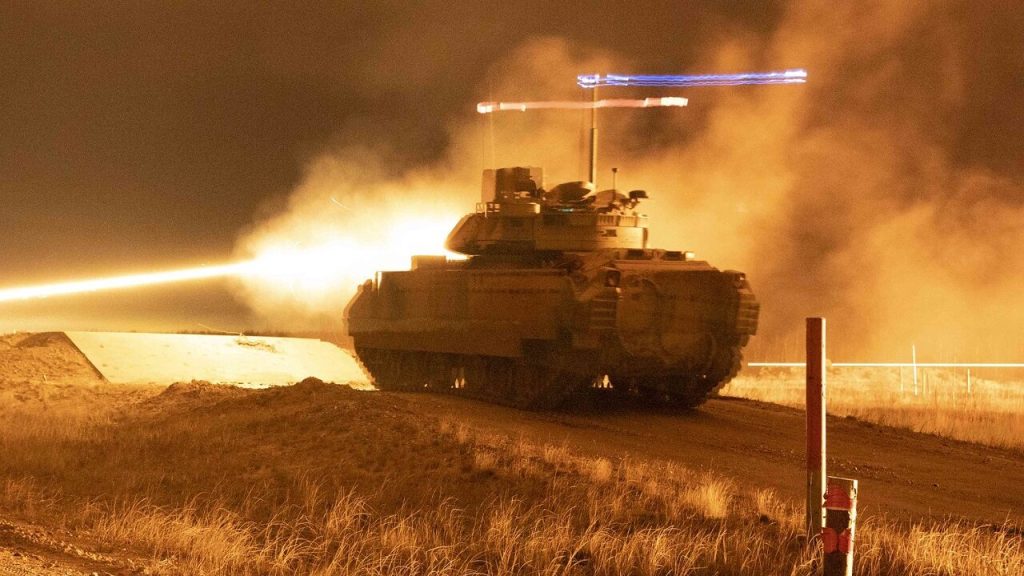The Bradley Fighting Vehicle was a tried-and-true weapon system in the United States in the 1980s.

Together with the AH-64 Apache helicopter gunship and the B-2 Spirit “Stealth Bomber,” the Bradley Fighting Vehicle is an example of an American-made weapons system that saw development in the 1980s, saw extensive use in the 1990s, and is still in use today.
In addition, the Bradley was one of those weapons systems that experienced significant growing pains due to cost overruns or reliability concerns, which sparked public controversy and cast doubt on whether things would ever become feasible in the first place. (“Hindsight is always 20/20, right?”)
Knowing this, let’s examine Bradley’s history and its prospects for the future.
Omar Nelson Bradley (1893–1981) was the U.S. Army officer who ascended through the ranks during World War II to become the first Chairman of the Joint Chiefs of Staff, serving in this capacity from August 1949 to August 1953 and earning a fifth star for his contributions. Now developed by BAE Systems, the Bradley vehicle carries his name.
Given the well-documented disagreements between the religiously observant General Omar Bradley and the more flamboyantly profane General George S. Patton, Jr., one cannot help but wonder whether Bradley is turning in his grave over the naming of an infantry fighting vehicle in his honour. In contrast, at least four main battle tanks were awarded to Patton in his honour. But I am getting off-topic.
Bradley was intended to replace the M113, which had been in service with the U.S. Army since 1960. To make a long tale short, it endured a period of development hell comparable to that of the entertainment and software industries. According to Kevin Bonsor of the website HowStuffWorks:
A replacement for the M113, the Bradley Fighting Vehicle production began in 1981. The Bradley has a superior suspension, making it faster in off-road conditions, and is generally considered more powerful and faster than the M113. Concerns about Bradley’s durability and efficacy in battle arose after it entered service.
The 1998 film The Pentagon Wars, starring Kelsey Grammar and Cary Elwes, depicts the dispute surrounding the development of the Bradley in a fictionalized and comical manner. However, it is nevertheless based on a great deal of actual historical events. The film is based on the nonfiction book The Power Game: How Washington Works by Pulitzer Prize winner Hedrick Smith, who honoured Pentagon whistleblower and retired U.S. Air Force Col. James G. Burton (Elwes) in his 1988 bestseller. A former classmate of mine at the University of Southern California (USC) and a military veteran himself, J. Scott Matey (retired Army LTC in his instance), recommended that I watch The Pentagon Wars because “it’s a case study on what not to do!”
Suffice it to say that thanks in large part to Col. Burton’s efforts to blow the whistle, the M2A2 and M3A2 variants of the Bradley received much-needed upgrades, such as new composite armor, improved ammunition storage to protect personnel, a higher water barrier skirt to improve amphibious operation, and an improved suspension system.
After weathering public, congressional, and Pentagon whistleblower criticism, Bradley should be tested in Operation Desert Storm.
M2 Bradleys destroyed more Iraqi armored vehicles than the legendary M1 Abrams main battle tank during the 1991 Persian Gulf War. While the enemy fire shot down only three Bradleys, a worrying 17 were involved in “blue-on-blue” instances when the friendly fire was mistaken for enemy fire. According to a report by the United States Government Accountability Office (GAO):
Bradley’s armament was devastating and efficient against many adversaries. The 25-mm automatic cannon has been praised for its adaptability by commanders, crews, and officials from the Army Infantry Center and the Center for Army Lessons Learned (CALL). The crews largely employed the 25-mm automatic cannon we talked to for clearing bunkers and firing on lightly armored vehicles. Vehicle commanders, crews, and CALL and Army Infantry Center staff reported sporadic incidents in which the 25-mm automatic gun had killed tanks, even though it is not the weapon of choice for attacking tanks. Very few malfunctions were attributed to Bradley’s TOW missile system, effectively killing tanks and other enemy armour from great distances. For instance, members of the 1st Armored Division and the 2nd Armored Cavalry Regiment claimed to have used the TOW to eliminate Iraqi armored vehicles. Crews reportedly destroyed tanks at ranges ranging from 800 meters to 3,700 meters.
Despite the 20 casualties, the study found that the Bradley has a high survivability for crew and troops. Yet, the vehicle proved vulnerable to IEDs and RPGs during Operation Iraqi Freedom (OIF) the next decade; in 2006 alone, 55 Bradleys were destroyed, and 700 others were damaged. By the end of OIF, approximately 150 Bradleys had ended up destroyed.
In light of these flaws, the Army started developing the Ground Combat Vehicle (GCV) in 2010 to replace the M2 Bradley. So far, though, that process has not been going easily, which may be a case of history repeating itself.
On the website of the Project on Government Oversight (POGO) watchdog organization, Pulitzer Prize winner Mark Thompson has produced a particularly damning study of the replacement program, punnily titled “The Army’s Lousy Tracked Record.”





